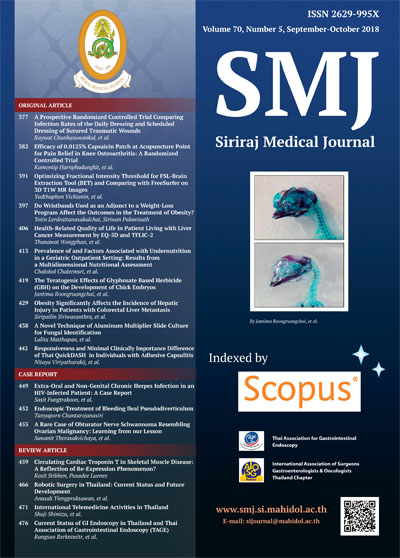A Prospective Randomized Controlled Trial Comparing Infection Rates of the Daily Dressing and Scheduled Dressing of Sutured Traumatic Wounds
Keywords:
Traumatic wound infection; scheduled dressing; daily dressingAbstract
Objective: To evaluate outcome differences between DD and SD in 1) wound infection rates, 2) patients’ satisfaction
according to the wound care and cost of treatment.
Methods: A single-center, prospective randomized controlled trial of 350 traumatic-wound patients was conducted. Only adult
traumatic wounds without a fracture, tendon injury and neurovascular injury were included. The patients were randomized
into two groups: daily dressing (DD) and scheduled dressing (SD) groups. DD group patients received daily wound dressing
changes, while those in SD group typically had dressing changed on days 3, 7 and one other scheduled day. Analyzed
data included patients’ demographics, clinical parameters, patient’s satisfaction according to wound treatment and cost.
Results: Total wound infection rate was 1.2%. Although the incidence of wound infection in the SD group was
lower than that of the DD group (0% vs 2.4%), statistically it was not significant (p=0.06). Patients’ satisfaction level
was also not significantly different between the two groups.
Conclusion: The study showed clinical non-inferiority of SD compared to DD while offering saving benefits both
in time and cost. Therefore, SD can be substituted for DD for traumatic wound care after primary repair.
Downloads
Published
How to Cite
Issue
Section
License
Authors who publish with this journal agree to the following conditions:
Copyright Transfer
In submitting a manuscript, the authors acknowledge that the work will become the copyrighted property of Siriraj Medical Journal upon publication.
License
Articles are licensed under a Creative Commons Attribution-NonCommercial-NoDerivatives 4.0 International License (CC BY-NC-ND 4.0). This license allows for the sharing of the work for non-commercial purposes with proper attribution to the authors and the journal. However, it does not permit modifications or the creation of derivative works.
Sharing and Access
Authors are encouraged to share their article on their personal or institutional websites and through other non-commercial platforms. Doing so can increase readership and citations.











